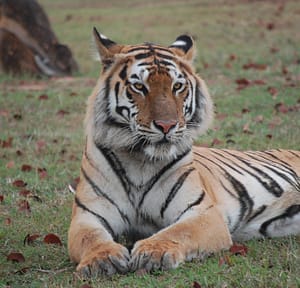What Do Tigers Eat? Exploring the Dietary Habits of These Majestic Predators
Introduction
Tigers, often regarded as some of the world’s most magnificent creatures, are renowned for their strength, agility, and, of course, their powerful hunting abilities. But have you ever wondered, “What do tigers eat?” In this comprehensive guide, we delve into the fascinating dietary habits of these ferocious predators. From their carnivorous nature to their preferred prey, we’ll explore the intriguing world of tiger diet.
Tiger Diet Basics
Tigers are unequivocally carnivores, and their primary diet consists of flesh and certain forms of animal fats. This inherent nature as carnivores has honed their skills as formidable hunters. While tigers are considered among the world’s most deadly predators, they are not particularly skilled when it comes to hunting in groups, especially when their prey is a herd of livestock. As a result, tigers prefer solitary hunting, choosing to strike when their prey is away from its herd.
Prey Animals
 Tigers have no age bias when it comes to selecting their prey; their primary objective is to satisfy their appetite. However, they do have their favorite meals, which include boar, deer, buffalo, monkeys, antelopes, young elephants, and various other forms of livestock. In times of food scarcity, tigers may resort to eating fish, lizards, red crabs, toads, and even berries. Although tigers rarely attack humans, they may target ill, aged, or frail individuals, especially among certain species like the Indian and Siberian tigers.
Tigers have no age bias when it comes to selecting their prey; their primary objective is to satisfy their appetite. However, they do have their favorite meals, which include boar, deer, buffalo, monkeys, antelopes, young elephants, and various other forms of livestock. In times of food scarcity, tigers may resort to eating fish, lizards, red crabs, toads, and even berries. Although tigers rarely attack humans, they may target ill, aged, or frail individuals, especially among certain species like the Indian and Siberian tigers.
Tiger Species and Diet
Tiger diet can vary depending on the species and its natural habitat. For instance:
- Siberian Tigers: Favor wild boars and Manchurian wapitis but also prey on various deer species.
- The Caspian Tigers: An endangered species known for consuming larger animals like camels, yaks, and saiga antelopes.
- The Sumatran Tigers: Hunt for various deer species, including Malayan tapirs, muntjacs, and sambars.
- Bengal Tigers: Prefer deer, native barasingas, buffalo, chital, gaurs, and several species of boars.
Conservation and Diet
Tiger diet plays a crucial role in conservation efforts. As their natural habitats are threatened, it becomes even more vital to protect their food sources. Preservation efforts focus not only on the tigers themselves but also on preserving the ecosystems that sustain their prey animals.
Dietary Myths
It’s essential to debunk some common misconceptions about tiger diets. For instance, tigers do not exclusively prey on large mammals; they are known to eat a variety of animals, including fish and even berries.
Human-Tiger Conflict
Human-tiger conflict is a complex issue that needs to be addressed. Documented cases, reasons behind such conflicts, and potential resolutions are explored in this section.
Evolutionary Diet
Understanding the historical diet of tigers provides insight into their evolutionary adaptations. Tigers have continually evolved their dietary preferences over millions of years.
Geography and Diet
The diet of tigers can vary based on geographical regions, influenced by the availability of prey animals in those areas.
Zoo Tigers and Diet
Maintaining a balanced diet for tigers in captivity presents unique challenges. This section explores the efforts to provide proper nutrition for tigers living in zoos and sanctuaries.
Nutrition and Health
Tigers require essential nutrients like protein, vitamins, and minerals for their well-being. This section outlines their nutritional needs.
Dietary Facts
Uncover intriguing and lesser-known facts about what tigers eat, including their occasional consumption of uncommon foods.
Conclusion
In conclusion, the dietary habits of tigers are both fascinating and critical for their survival. Protecting their natural habitats, prey animals, and addressing human-tiger conflict are essential steps in conserving these magnificent predators. Understanding what tigers eat not only sheds light on their biology but also emphasizes the importance of their conservation.









